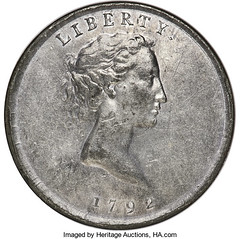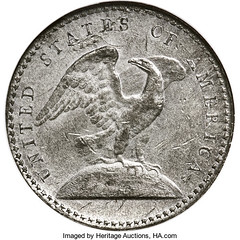
PREV ARTICLE
NEXT ARTICLE
FULL ISSUE
PREV FULL ISSUE
MORE ON THE 1792 EAGLE-ON-GLOBE PATTERN

Bill Eckberg writes: "The Heritage lot description, relying on traditional speculation from the 1960s, reads like an advertisement, which it is, for a spectacularly important coin, which it may or may not be. "Pete Smith's revisionist comments are spot on. "Readers might also be reminded that Crosby referred to it as a cent, not a quarter and that, though a piece in copper came into the Mint collection from Adam Eckfeldt, nothing is known of its origin. Even Eckfeldt didn't claim to know anything about it. "It is also worth noting that on his deathbed, Wright requested to be paid for the Henry Lee Comitia Americana medal dies he engraved and for the dies for a quarter dollar pattern that broke in hardening. His estate was paid only for the dies for the medal. The Eagle-on-Globe dies obviously struck a few pieces and so apparently did not break in hardening, suggesting that it was not the quarter dollar pattern. "It's a lovely piece, but there's no evidence it was engraved by Wright, that it was a 1792 pattern, or, if it WAS a pattern from the early Mint, what it was a pattern for. "Like the suppositions about the "Continental Dollar," the suppositions about this piece are all inventions from numismatists writing over a century and a half after the date on the coin. "We need, at some point, to require evidence for spectacular claims like the ones about this piece." Alan V Weinberg writes: "Regarding the "2002 discovery" of the two 1792 Judd 13 white metal Wright quarters: Actually, I saw both pieces on display in a vertical glass display case with other early American pieces (including a gold Erie Canal medal) in 1999 while visiting the New-York Historical Society, and at that time inquired of NYHS curator Ms. Hofer of their origin, learning only they'd been in the Society collection back to 1808, its founding. "I almost immediately decided to work a trade of my unique hand-engraved large gold 1854 New York lifesaving medal for one of the two Judd 13s and was told this trade would have to be approved by the NY state legislature. "I made the mistake of mentioning the proposed trade to a prominent NYC dealer who advised the Society against such a trade." "So the pieces were "discovered" in 1999, not 2002." Thanks, everyone. Great discussion and background. -Editor
To read the earlier E-Sylum article, see:

Wayne Homren, Editor The Numismatic Bibliomania Society is a non-profit organization promoting numismatic literature. See our web site at coinbooks.org. To submit items for publication in The E-Sylum, write to the Editor at this address: whomren@gmail.com To subscribe go to: https://my.binhost.com/lists/listinfo/esylum All Rights Reserved. NBS Home Page Contact the NBS webmaster 
|